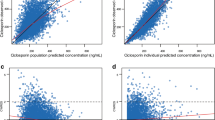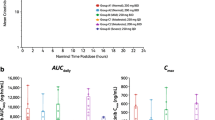Summary
The plasma concentration of micafungin (MCFG) after intravenous infusion of MCFG at 150 or 300 mg/day over 1 hour to 49 patients with hematologic malignancies were determined, and the relationship between the plasma concentrations and the patients’ laboratory parameters of liver and kidney function was analyzed. Plasma samples were obtained at the end of the initial administration of MCFG, 5 to 6 hours after the start of the initial administration, immediately before the second dosing, immediately before the fourth dosing, and the end of the fourth dosing. The plasma concentration of MCFG was measured by high performance liquid chromatography. The plasma concentration of MCFG was correlated with the doses of MCFG per kilogram body weight. The peak concentration after the initial administration was 3.8 times higher than the trough level after the initial administration. The steadystate peak and trough levels were 1.4–1.5 times higher than those after the initial administration. There was no correlation between the laboratory parameters of liver/kidney function and the dose-normalized plasma concentration of MCFG. These results suggest that MCFG can be administered safely to patients with liver or kidney dysfunction without adjusting the dose.
Similar content being viewed by others
References
Comely O.A., Ullmann A.J., Karthaus M. (2003): Evidence-based assessment of primary antifungal prophylaxis in patients with hematologic malignancies. Blood, 101, 3365–3372.
Kohno S., Yamaguchi H. (2002): Overview of micafungin (MCFG). Jap. J. Chemother., 50(S−1), 1–7.
Ikeda F., Otomo K., Nakai T., Morishita Y., Maki K., Tawara S., Mutoh, S., Matsumoto. F., Kuwahara, S. (2002): In vitro activity of a new lipopeptide antifungal agent, micafungin against a variety of clinically important fungi. Jap. J. Chemother., 50(S−1), 8–19.
van Burik J.A., Ratanatharathorn V., Stepan D.E., Miller C.B., Lipton J.H., Vesole D.H., Bunin N., Wall D.A., Hiemenz J.W., Satoi Y., Lee J.M., Walsh T.J.; National Institute of Allergy and infectious Diseases Mycoses Study Group. (2004): Micafungin versus fluconazole for prophylaxis against invasive fungal infections during neutropenia in patients undergoing hematopoietic stem cell transplantation. Clin. Infect. Dis., 39, 1407–1416.
Ishikawa T., Takata T., Tomoyose T., Masuda M., Nakachi S., Koga S., Tsukada J., Matsuura A., Utsunomiya A., Saburi Y., Tamura K. (2006): The efficacy of micafungin as an empiric therapy for febrile neutropenic patients refractory to antibacterial agents. Jap. J. Chemother., 54, 125–128.
Yanada M., Kiyoi H., Murata M., Suzuki M., Iwai M., Yokozawa T., Baba H., Emi N., Naoe T. (2006): Micafungin, a novel antifungal agent, as empirical therapy in acute leukemia patients with febrile neutropenia. Intern. Med., 45, 259–264.
Kohno S., Masaoka T., Yamaguchi H., Mori T., Urabe A., Ito A., Niki Y., Ikemoto H. (2004): A multicenter, open-label clinical study of micafungin (FK463) in the treatment of deep-seated mycosis in Japan. Scand. J. Infect. Dis., 36, 372–379.
Ostrosky-Zeichner L., Kontoyiannis D., Raffalli J., Mullane K.M., Vazquez J., Anaissie E.J., Lipton J., Jacobs P., Jansen van Rensburg J.H., Rex J.H., Lau W., Facklam D., Buell D.N. (2005): International, open-label, noncomparative, clinical trial of micafungin alone and in combination for treatment of newly diagnosed and refractory candidemia. Eur. J. Clin. Microbiol. Infect. Dis., 24, 654–661.
Ruhnke M. Kuse E., Chetchotisakd P., da Cunha C.A., Diekmann-Berndt H. (2005): Comparison of micafungin and liposomal amphotericin B for invasive candidiasis. Program, 228 Forty-fifth Interscience Conference on Antimicrobial Agents and Chemotherapy, Washington DC. (Abstract. No.M-722c).
Kuse E.R., Chetchotisakd P., da Cunha C.A., Ruhnke M., Barrios C., Raghunadharao D., Sekhon J.S., Freire A., Ramasubramanian V., Demeyer I., Nucci M., Leelarasamee A., Jacobs F., Decruyenaere J., Pittet D., Ullmann A.J., Ostrosky-Zeichner L., Lortholary O., Koblinger S., Diekmann-Berndt H., Comely O.A. (2007): Micafungin Invasive Candidiasis Working Group. Micafungin versus liposomal amphotericin B for candidaemia and invasive candidosis: a phase III randomised double-blind trial. Lancet, 369(9572), 1519–27.
Yamato Y., Kaneko H., Tanimoto K., Katashima M., Ishibashi K., Kawamura A., Terakawa M., Kagayama A. (2002): Simultaneous determination of antifungal drug, micafungin, and its two active metabolites in human plasma using high-performance liquid chromatography with fluorescence detection. Jap. J. Chemother., 50(S−1), 68–73.
Azuma J., Nakahara K., Kagayama A., Kajiho T., Kawamura A., Suematsu H. Mukai T. (2002): Phase I study of micafungin. Jap. J. Chemother., 50(S−1) 104–147.
Azuma J., Nakahara K., Kagayama A., Okuma T., Kawamura A., Mukai T. (2002): Pharmacokinetic study of micafungin. Jap. J. Chemother., 50(S−1), 155–184.
Azuma J., Nakahara K., Kagayama A., Fujiwara S., Kawamura A., Mukai T. (2002): Pharmacokinetic study of micafungin in elderly subjects. Jap. J. Chemother., 50(S−1), 148–154.
Tabata K., Katashima M., Kawamura A., Tanigawara Y., Sunagawa K. (2006): Linear pharmacokinetics of micafungin and its active metabolites in Japanese pediatric patients with fungal infections. Biol. Pharm. Bull., 29, 1706–1711.
Shimoeda S., Ohta S., Kobayashi H., Saitou H., Kubota A., Yamato S., Shimada K., Sasaki M., Kawano K. (2005): Analysis of the blood level of micafungin involving patients with hematological diseases: New findings regarding combination therapy with tacrolimus. Biol. Pharm. Bull. 28, 477–480.
Tabata K., Katashima M., Kawamura A., Kaibara A., Tanigawara Y. (2006): Population pharmacokinetic analysis of micafungin in Japanese patients with fungal infection. Drug Metab. Pharmacokin., 21, 324–331.
Yamato Y., Kaneko H., Hashimoto T., Katashima M., Ishibashi K. Kawamura A., Terakawa M., Kagayama A. (2002): Pharmacokinetics of the antifungal drug micafungin in mice, rats and dogs, and its in vitro protein binding and distribution to blood cells. Jap. J. Chemother., 50(S−1), 74–79.
Author information
Authors and Affiliations
Rights and permissions
About this article
Cite this article
Nakagawa, Y., Ichii, Y., Saeki, Y. et al. Effect of liver and kidney function on migafungin disposition in patients with hematologic malignancies. Eur. J. Drug Metabol. Pharmacokinet. 33, 191–198 (2008). https://doi.org/10.1007/BF03191118
Received:
Issue Date:
DOI: https://doi.org/10.1007/BF03191118




